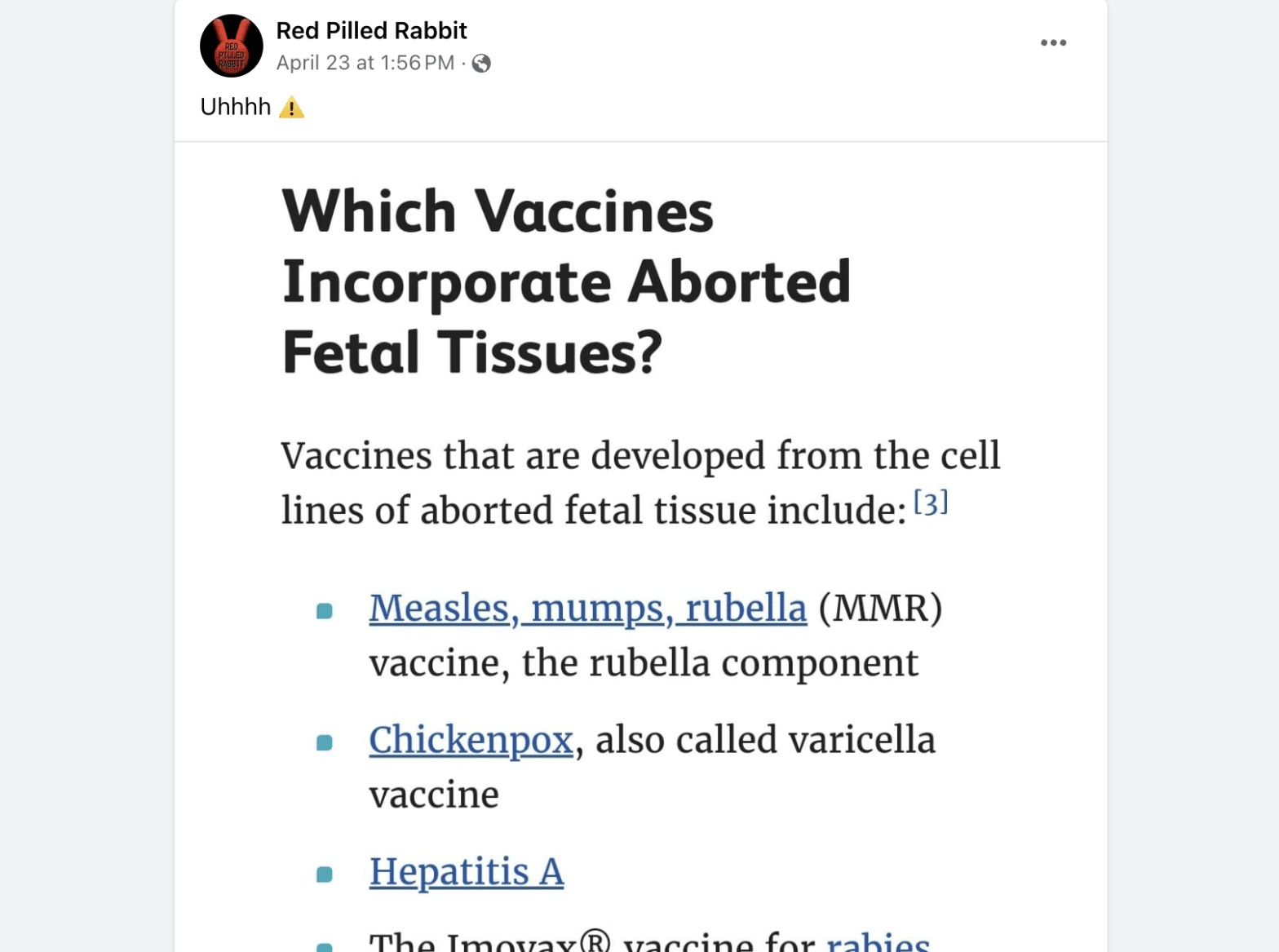- Health
Vaccines don’t contain cells or tissues of aborted fetuses
Key takeaway
Several vaccines use full viruses that have been modified in the lab to be harmless to humans but still able to train the immune system to fight a specific pathogen. Manufacturing viruses requires the use of human cells to grow them because viruses cannot proliferate outside a cell. These cells are sometimes derived from a few fetuses aborted at least three decades ago. However, these cells are destroyed and removed during the vaccine manufacturing process. Therefore, vaccines don’t contain tissues from aborted fetuses.
Reviewed content

Verdict:
Claim:
Some vaccines “incorporate aborted fetal tissue”
Verdict detail
Misleading: Human cells grown in laboratories, which are sometimes derived from fetuses aborted decades ago, are used to make certain vaccines containing viruses as a key ingredient. This is necessary because viruses need cells to replicate. However, these cells are destroyed and filtered out during the vaccine manufacturing process. The final vaccine products don’t contain these cells.
Full Claim
The MMR, chickenpox, hepatitis A vaccines, as well as the Imovax rabies vaccine and the Johnson & Johnson COVID-19 vaccines “incorporate aborted fetal tissue”
Review
The claim that some vaccines contain animal cells or tissues from aborted human fetuses is a recurring theme of vaccine misinformation. Science Feedback explained on several occasions that this is misleading. Vaccine manufacturing processes sometimes use cells of human origin to mass-produce some vaccine ingredients, but those cells are eventually eliminated and don’t remain in the final product.
A new iteration of that claim was posted in April 2024 by the Facebook page “Red Pilled Rabbit”, which has more than 16,000 followers. This iteration of the claim used a screenshot of an article from the website VerywellHealth, which listed five different vaccines under the subheader “Which Vaccines Incorporate Aborted Fetal Tissues?” This language strongly implied that fetal tissues from abortion are still present in certain vaccines when they’re administered to people, including the measles, mumps, rubella vaccine (MMR), the chickenpox (varicella) vaccine, the Hepatitis A vaccine, the rabies vaccine Imovax, and the COVID-19 vaccine from Johnson & Johnson.
Just like previous versions of this claim, this is misleading. Although producing these vaccines requires the use of human cells, the cells are eliminated during the manufacturing process.
The reason for using cells as part of the manufacturing process is that all of these vaccines contain whole viruses. Viruses are obligate intracellular parasites; in other words, they cannot replicate themselves outside of a cell. Therefore, it’s necessary to use cells or tissue cultured in the laboratory to grow them.
It’s also important to stress that viruses used in vaccines are different from the viruses one may encounter in nature.
Some are chemically inactivated (killed), which means that they cannot infect our cells nor multiply within them. This is the case of the viruses in the hepatitis A and rabies vaccines.
Others are live but attenuated, like those in the MMR and chickenpox vaccines. This means that the viruses have been modified so they aren’t a threat to humans anymore.
Finally, the virus in the Johnson & Johnson COVID-19 vaccine is an adenoviral vector that carries the genetic material of the SARS-CoV-2 spike protein. This type of virus is modified in the lab to be unable to replicate itself.
Regardless of the type of vaccine, inactivated, attenuated or adenoviral, the main goal of the manufacturing process is to produce large amounts of the required virus.
Manufacturers use the MRC-5 cell strain to produce the viruses for the chickenpox, Hepatitis A and rabies vaccines. Johnson & Johnson used the cell line PER.C6 to produce the adenoviral vector of its COVID-19 vaccines. The rubella virus from the MMR vaccine is produced in the MRC-5 or in the WI-38 cell strains, depending on the vaccine brand.
Both MRC-5 and WI-38 are fibroblast cell strains originally isolated from the lung tissue of fetuses resulting from elective pregnancy terminations in the 1960s and have been cultured in the laboratory since[1,2]. The PER.C6 cell line, originally derived from embryonic retinal cells, was isolated in 1985 from an aborted 18-week fetus[3].
Vaccine manufacturers multiply these cells to produce the virus necessary for the first part of the vaccine manufacturing process. This is referred to as upstream processing. Once there is a sufficient amount of virus, the cells are destroyed by chemical treatments and the virus is purified. This is known as downstream processing.
Manufacturing processes are generally proprietary, so details about them aren’t publicly available. However, a U.S. Food and Drug Administration (FDA) document about the hepatitis A vaccine mentions that the MRC-5 cells used for virus production during the upstream process are destroyed and that the viruses are purified.
In summary, the human-derived cells necessary for growing viruses are removed towards the end of the vaccine manufacturing process. Therefore, vaccines don’t contain human cells or tissues.
REFERENCES:
- 1 – Hayflick L. (1965) The limited in vitro lifetime of human diploid cell strains. Experimental Cell Research.
- 2 – Jacobs et al. (1970) Characteristics of a Human Diploid Cell Designated MRC-5. Nature.
- 3 – Fallaux et al. (1998) New helper cells and matched early region 1-deleted adenovirus vectors prevent generation of replication-competent adenoviruses. Human Gene Therapy.



